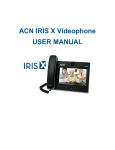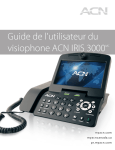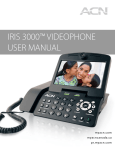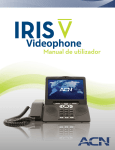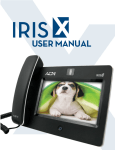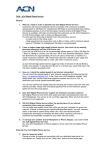Download ACN Videophone User manual
Transcript
Videoph o n e USER MANUAL Contents 1. Your ACN Videophone..................................................................4 1-1. Videophone components.............................................................................................................. 4 1-2. Safety instructions........................................................................................................................ 5 1-3. Getting to know your Videophone................................................................................................ 6 1-4. Installing your Videophone........................................................................................................... 8 2.Using the Basic Functions of your Videophone.....................................9 2-1. Placing a call .............................................................................................................................. 9 2-1-1. Placing a call using the keypad....................................................................................... 9 2-1-2. Placing a call in standby mode (when the LCD screen is off)......................................... 9 2-1-3. Placing a call from your Call Log .................................................................................... 9 2-1-4. Placing a call from your Phonebook.............................................................................. 10 2-2. Receiving a call........................................................................................................................... 11 2-3. Rejecting a call............................................................................................................................ 11 2-4. Ending a call ............................................................................................................................ 11 2-5. Retrieving your Video/Voicemail ................................................................................................ 11 2-6. Your Videophone information..................................................................................................... 12 2-7. Useful functions during a call..................................................................................................... 12 2-7-1. Mute............................................................................................................................ 12 2-7-2. Privacy........................................................................................................................... 12 2-7-3. Volume control ............................................................................................................. 12 2-7-4. Brightness control . ...................................................................................................... 13 2-7-5. Hold ............................................................................................................................ 13 2-7-6. Audio Conferencing (3-Way Calling).............................................................................. 14 2-7-7. Call Waiting .................................................................................................................. 14 2-8. Call Forwarding........................................................................................................................... 15 2-9. Transferring calls to/from an auxiliary phone.............................................................................. 15 3. Set Up. ..................................................................................16 3-1. Main Menu ............................................................................................................................ 16 3-2. Using the keypad . ..................................................................................................................... 17 3-3. Entering characters..................................................................................................................... 17 3-3-1. Entering numbers......................................................................................................... 18 3-3-2. Entering letters ............................................................................................................ 18 3-3-3. Entering numbers and letters....................................................................................... 18 3-4. Phonebook ............................................................................................................................ 18 3-4-1. All contacts................................................................................................................... 18 3-4-1-1. Add new entry................................................................................................... 19 3-4-1-2. Place a call . ...................................................................................................... 19 3-4-1-3. Edit a contact..................................................................................................... 19 3-4-1-4. Delete a contact................................................................................................ 19 3-4-2. Search ............................................................................................................................ 20 3-4-2-1. Search by name................................................................................................. 20 3-4-2-2. Search by number............................................................................................. 20 3-4-2-3. Placing a call, updating and deleting information........................................................................ 20 3-4-3. Delete all....................................................................................................................... 21 3-5. Call log ............................................................................................................................ 21 3-5-1. Total calls...................................................................................................................... 22 3-5-2. Answered calls.............................................................................................................. 22 3-5-3. Dialled numbers............................................................................................................ 22 3-5-4. Missed calls ................................................................................................................. 22 3-5-5. Placing a call, saving or deleting a number................................................................... 23 3-6. Settings ............................................................................................................................ 24 3-6-1. System settings............................................................................................................ 24 3-6-1-1. Network............................................................................................................. 24 3-6-1-2. Factory reset .................................................................................................... 24 3-6-1-3. Sound................................................................................................................ 25 3-6-1-4. Display . ............................................................................................................ 26 3-6-2. Setting the time............................................................................................................ 28 3-6-4. Administrator settings................................................................................................... 29 3-7. Digital Photo Frame .................................................................................................................. 29 3-8. Information ............................................................................................................................ 29 Troubleshooting Guide....................................................................31 Warning Messages........................................................................33 1. Your ACN Videophone 1-1. Videophone components The following items should be included with your ACN Videophone. If an item is missing, please contact ACN Customer Services. Main Unit Ethernet Cable (RJ-45) Handset Power Adapter *Warning: Use the Power Adapter that comes with your Videophone. Use of any other power adapter, other than one provided by ACN, may result in corruption of your Videophone or even a fire. Telephone Cable (RJ-11) 1-2. Safety instructions This guideline is to advise you on user safely and prevention of any financial loss. Read thoroughly before using your Videophone. There are two types of precautions which are explained as follows: CAUTION When unplugging the power adaptor, turn off the power switch before removing the plug from the electrical outlet. • Unplugging while the power switch is on may cause your Videophone to malfunction. Do not install your Videophone in an unsafe place, or on an unstable surface. Use a soft fabric when cleaning the LCD screen and camera. • Your Videophone may not operate properly, or may not work at all. • Do not use strong chemical solutions or abrasive cleaning materials as they can damage your Videophone, especially the LCD screen and camera. Use the most accessible electrical outlet to install your Videophone. Warning Do not install your Videophone in a dusty environment or where it can be affected by gas. Do not disassemble or modify your Videophone or power adapter. The warranty will not cover any defect that occurs due to such mishandling. To avoid damage, over heating or the possibility of an electrical shock, do not install in a humid environment. Do not subject your Videophone to direct sunlight, or install it near heat sources, such as radiators. To avoid the possibility of an electric shock, do not touch the power adapter during thunder storms. To prevent damage, protect your Videophone from sudden shock. Do not apply excessive force, especially to the LCD screen or camera. A sudden change of temperature may cause damage to your Videophone. Disconnect the power cable when your Videophone is not in use for an extended period of time. Only use the power adapter supplied with your Videophone. 1-3. Getting to know your Videophone Front :@/ 4 7 GHI PQRS * 2 5 8 0 Handset Videophone handset 2 Speaker Plays ring tones and transfers audio in speakerphone mode. 3 Camera Captures images that are transmitted to the called party. 4 LCD Screen Displays your image and the image of the person you are talking to during a call. 5 Keypad Buttons that operate the functions of your Videophone. 6 Microphone Receives and transmits audio in speakerphone mode. POWER REGISTER 1 1 ABC JKL TUV -._ 3 6 9 DEF MNO WXYZ # . Rear I/O +12V DC POWER USB LAN WAN LINE PHONE VIDEO OUT AUDIO OUT ON/OFF (I/O) Turns your Videophone on/off POWER (DC IN) Connects to the power adapter USB USB port used to transfer data to/from your Videophone LAN Local Area Network connection WAN Connects to Internet via the Ethernet cable PHONE Connects a cordless or corded phone to your Videophone VIDEO OUT Transmits video to a TV or Computer AUDIO OUT Transmits audio to external speakers or audio system. LAN (Local Area Network) is a computer network covering a small geographic area, like a home, office, or a group of buildings i.e. a school. A home network is a residential local area network, and is used to connect multiple devices within the home. The simplest home networks are used to connect 2 or more computers for sharing files, printers, and a single connection to the Internet (usually broadband Internet through a cable or DSL provider). WAN (Wide Area Network) is a computer network that covers a broad area. WANs are used to connect LANs and other types of networks together, so that users and computers in one location can communicate with users and computers in other locations. The wide area network provides network address translation (NAT), allowing multiple devices such as computers or videophones to share one IP address and Internet connection. The router can be identified as it almost always has 5 Ethernet ports on the back. One port is separate from the four other ports. The largest and most well-known example of a WAN is the Internet. Keypad POWER REGISTER 1 :@/ 4 7 GHI PQRS * 2 ABC 3 DEF 5 JKL 6 MNO 8 TUV 9 0 -._ # . WXYZ (1) REGISTER The green LED light is on when your Videophone is connected to ACN’s Digital Phone Service. (2) POWER Indicates if your Videophone is switched on. (3) MAIL Allows you to retrieve video/voicemail. (4) HOLD Enables you to place calls on hold. (5) MUTE Disables the voice transmission during the call. (6) PHONEBOOK Provides access to your personal phonebook. (7) CONFERENCE Allows you to audio conference multiple callers on to one call (3-Way Calling). (8) PRIVACY Temporarily disables the video signal transmission during a call. (9) * Enters “*” (10) NUMERIC KEYPAD Enters phone number in the dialling mode or letters in the “Settings” menu. (11) # Enters “#”. Rejects the incoming call. (12) MENU Activates the “Main” menu on your LCD screen. (13) BACK Moves to the previous menu from the “Settings” menu or “Set Up” menu during a call and deletes characters when entering information. (14) MY CONTENT Lists available content. (15) UP NAVIGATION Up navigation button. (16) OK Use to enter selections and save settings in the “Settings” menu. (17) DOWN NAVIGATION Down navigation button. (18) LEFT NAVIGATION Left navigation button. (19) RIGHT NAVIGATION Right navigation button. (20) STATUS Lists information needed for technical support i.e. configuration and software version (21) CAPS Allows you to enter capital letters and selects the type of letters or characters to enter. Switches between numeric, lower-case letters and upper-case letters. (22) MY APPLICATIONS Lists available applications. (23) REDIAL Makes a call to the last number dialled. (24) SPEAKER Activates/deactivates the speakerphone. (25) CALL Makes a call to the dialled number. 1-4. Installing your Videophone Please check to ensure you have the following components before installing your Videophone. For optimal results, please follow the installation procedures provided in the Quick Installation Guide, which is included with your Videophone. Connect the handset to the connection point located on the side of your ACN Videophone. Connect the power adaptor to the power port. Connect the Ethernet cable to the WAN port. Turn the Power Switch on. NOTE: Your Videophone may take up to 3 minutes before it is ready to use. During this time the system will perform an initial software update and connect to ACN’s Digital Phone Service. The LCD screen will display a status as it moves through the process. When the process is complete, the registration light will turn green. 2.Using the Basic Functions of your Videophone 2-1. Placing a call 2-1-1. Placing a call using the keypad Pick up the handset or press the “Speaker” button • Enter the phone number • Press the “Call” button NOTE: Refer to Section 3-2 for instructions on entering characters. The keypad tones are switched off by default. If you would like to switch on the keypad tones, refer to Section 3-6-1-3 Sound. 2-1-2. Placing a call in standby mode (when the LCD screen is off) Enter the first digit of the phone number • A window will appear on the screen • Enter the remaining digits of the phone number • Press the “Call” button 2-1-3. Placing a call from your Call Log Press the “MENU” button • Use the navigation buttons “ ” to select “Call Log” • Press the “OK” button • Select the category of the number you would like to call (Total Calls, Answered Calls, Dialled Numbers, Missed Calls) by using the navigation buttons “ ” (for example: select “Dialled”) • Press the “OK” button • Use the navigation buttons “ ” to select the desired number • Press the “OK” button • Use the navigation buttons “ ” to select “Make A Call” • Press the “OK” button Select “Call Log” from the Main Menu Select the required call category Select the number you would like Select “Make A Call” and press the “OK” button to call and press the “OK” button 2-1-4. Placing a call from your Phonebook Press the “MENU” button when the LCD screen is off or in idle mode. • The Main Menu is displayed • Select the Phonebook menu by using the navigation buttons “ ” • Press the “OK” button OR • Press the “Phonebook” button located on the front of your Videophone. • Select “All Contacts” by using the navigation buttons “ • Select the desired contact and then press the “Call” button ” or the “OK” button • Select the number (video, mobile, home, company phone number) you would like to call ” by using the navigation buttons “ • Press the “OK“ button Select “Phonebook” from the Main Menu Select “All Contacts” Select the desired contact and press Select the number you would like to call and press the “OK” button the “Call” button or the “OK” button 10 2-2. Receiving a call When your Videophone rings the LCD screen will show the person calling or the name and phone number of the person calling. Pick up the handset or press the “Speaker” button to answer the call. If there is a picture associated with a contact, it will be displayed. 2-3. Rejecting a call If you are unable, or do not want to answer, a call simply press the button to reject it. The call will then be sent directly to your voicemail. 2-4. Ending a call Simply hang up the handset or if you are in speakerphone mode, press the “Speaker” button . NOTE: Your call data will be stored in your Call Log. 2-5. Retrieving Video/Voicemail your An envelope will appear in the bottom right-hand corner of your screen indicating that you have video/voicemail and the number of message(s) waiting. To retrieve your video/voicemail: • Press the “Mail” button on the front of your Videophone • Enter your 4 digit access code and press # • Press 1 to retrieve your video/voicemail • If you have mail, the voice prompt will indicate whether it is a voicemail or video message. 11 Video/Voicemail Functions Press Command # Key Save your message 7 Erase your message 2 Repeat your message 4 Go back to your previous message 5 Play your message 6 Go to your next message 8 Return the call 9 Additional options * Key Go back to the previous menu 2-6. Your Videophone information Select the “Information” icon from the Main Menu to view information about your Videophone. Press the “Back” 2-7. Useful or the “OK” button on the front of your Videophone to exit. functions during a call 2-7-1. Mute Press the “Mute” button to prevent the other party from hearing you speak. To release mute, press the “Mute” button again. 2-7-2. Privacy Press the “Privacy” button to keep your image from being displayed to the other party. In privacy mode, instead of your image, a logo image is displayed on the other party’s screen. To exit from privacy mode, press the “Privacy” button again. 2-7-3. Volume control You can control the volume by using the navigation buttons “ “ during a call. The volume icon is shown at the top of the LCD screen. 12 “ ” Lowers the volume “ “ Increases the volume In order to control the volume during a call: • Press the “MENU” button ” • Select “Volume Control” by using the navigation buttons “ • Press the “OK” button • Use “ “ to adjust the volume to return to the previous menu • Press the “Back” button 2-7-4. Brightness control You can adjust the LCD brightness by using the navigation buttons “ “ during a call. The brightness icon is shown at the top of the LCD screen. In order to control the LCD brightness during a call: • Press the “MENU” button • Select “Brightness Control” by using the navigation buttons “ ” • Press the “OK” button • Use “ “ to adjust: • Press the “Back” button to return to the previous menu 2-7-5. Hold You can place a call on hold by pressing the “Hold” button during a call. The LCD screen will then become dark and not display anything. To resume your call, simply press the “Hold” button again. Caller will see “Hold” Person called will see “On Hold” 13 2-7-6. Audio Conferencing (3-Way Calling) The Audio Conferencing function enables 3-way calling during a voice call. To activate press the “Hold” button during the call. This will place the existing caller on hold. Caller will see “Hold” Person called will see “On Hold” • Dial the number of the 3rd person you would like to conference in and press the “Call” button • When the 3rd party answers, press the “Conference” button NOTE: If the person who initiated the conference call hangs up during the call, it will end the call for all parties. 2-7-7. Call Waiting You will hear a stutter tone to indicate an incoming call and the caller ID information will be displayed. • To accept the incoming call, press “1” (the existing call will be placed on hold) • To reject the call, press “2” (the new caller will hear a busy signal) • Once the incoming call is completed, press the “Hold” button again to reconnect to the original caller. 14 2-8. Call Forwarding The Call Forwarding feature enables you to forward your calls to another telephone number or to your voicemail. To activate this feature simply following the below instructions depending on the option you would like: Call Forwarding Always Activation Press *72 followed by the “Call” button , then the number that you would like your calls forwarded to followed by the # key De-activation Press *73 followed by the “Call” button Call Forwarding Always to Voicemail Activation Press *21 followed by the “Call” button De-activation Press #21 followed by the “Call” button Call Forwarding to Busy (caller will hear a busy signal) Activation Press *90 followed by the “Call” button De-activation Press *91 followed by the “Call” button Call Forwarding Busy to Voicemail (caller will be forwarded to voicemail if you are on another call) Activation Press *40 followed by the “Call” button De-activation Press #40 followed by the “Call” button Call Forwarding No Answer Activation Press *92 followed by the “Call” button , then the number that you would like your calls forwarded to followed by the # key De-activation Press *93 followed by the “Call” button Call Forwarding No Answer to Voicemail (caller will be forwarded to voicemail if there is no answer) Activation Press *41 followed by the “Call” button De-activation Press #41 followed by the “Call” button Please note, ACN’s standard rates apply to the forwarded call depending on the fixed or mobile number the call is forwarded to. 2-9. Transferring calls to/from an auxiliary phone To transfer calls to or from an auxiliary phone connected to the phone port of your Videophone simply do the following: Transferring calls from your Videophone Press the “Call” button . The auxiliary phone will ring. Simply answer the auxiliary phone to complete the transfer. Transferring calls to your Videophone Press *1 on the auxiliary phone to transfer audio only to your Press *2 on the auxiliary phone to transfer both audio and video Videophone. to your Videophone. 15 3. Set Up 3-1. Main Menu Press the “MENU” button to display the Main Menu. NOTE: To navigate the menu screen, use the “ ” buttons to until you reach the desired menu item, then press the “OK” button Main Menu selections • Save contact names and phone numbers for frequently dialled numbers • Search for phone numbers by name and number • Place calls directly • View recent calls in your Call Log, including total calls, answered calls, dialled numbers and missed calls • Place calls directly • Provides access to a variety of settings, including System, Time, Upgrade and Administrator settings • In the “System Settings” menu you can manage your Sound and Display options, in addition to accessing your network settings and the Factory Reset function. • In the “Network” menu you can access your Net and Interface settings. To adjust these settings please contact ACN Customer Services. • Factory Reset allows you to delete your configuration and reset to the factory defaults. If this is necessary, ACN Customer Services will provide you with the password to reset your Videophone • In the “Sound” menu, you can set your Ring Tones, Ring Volume, Sound Effects, Sound Volume and Audio Output. • The “Display” menu allows you to activate and manage Video Output, LCD Brightness, Upload Bandwidth, Picture Capture (captures and saves pictures from live video conversation, which you can associate with your phonebook contacts), Self View, Power Saving (controls timing for Digital Photo Frame and Wallpaper), Wallpaper and your Digital Photo Frame and Language options. • The “Time Setting” menu allows you to set the time parameters such as NTP, DST, and GMT. • In the “Upgrade” menu, you can access the Upgrade Server Address and the method for upgrading your software. To adjust these settings please contact ACN Customer Services. • The “Administrator” menu provides access to SIP, A/V Codec settings, DNS, Proxy and LAN settings. To adjust these settings please contact ACN Customer Services. Digital Photo Frame • The Digital Photo Frame allows you to view the pictures from your memory stick or SD card as a slide show Information • The Information screen shows you the main system settings for your Videophone Phonebook Call Log Settings 16 3-2. Using the keypad Numeric keys • Used for character input (Caps) • Enables you to select the type of characters to enter (Numeric/Lowercase/Capital) (Back) • Enables you to return to the previous menu (OK) • Used to select and confirm selections • Used to navigate between menus • Directs you to edit mode, and allows you to set values for selected items Navigation buttons 3-3. Entering characters Press the “Caps” button to select the required input mode (Numeric/Lowercase/Capital). The current input type is indicated at the top left of the LCD screen, represented by one of the following icons: Indicates numeric Indicates lowercase letters Indicates capital letters Key Mode Lowercase Capital Numeric :@/ :@/ 1 abc ABC 2 def DEF 3 ghi GHI 4 jkl JKL 5 mno MNO 6 pqrs PQRS 7 tuv TUV 8 wxyz WXYZ 9 “.” “-“ 0 * * * # # #. Space Space space 3-3-1. Entering numbers Example: To enter “123”: • Press the “Caps” button • Press the until the appears at the top left of the screen. buttons consecutively. 17 3-3-2. Entering letters • Press the ”Caps” button until the appears at the top left of the screen. • Press the corresponding buttons until the desired letter appears. Example: To enter “SKY”: • Press the “Caps” button to set the input mode to • Press the corresponding buttons for ‘S’, ‘K’, ‘Y’ consecutively: 3-3-3. Entering , , numbers and letters Example: To enter “123.com” • Press the “Caps” button to set the input mode to • Press the buttons consecutively. • Press the “Caps” button to set the input mode to . . • Press the corresponding buttons for ‘”com” until the desired letter appears: , • Press the , buttons consecutively 3-4. Phonebook The Phonebook enables you to save any frequently dialled numbers as contacts, and place phone calls directly. Up to 300 contacts can be stored in the Phonebook. Select “Phonebook” from the Main Menu 3-4-1. All Phonebook menu contacts “All Contacts” lists all the contacts you have saved in your Phonebook. You can edit, save or delete your contact information. Select “All Contacts” from the Phonebook menu 3-4-1-1. Add “All Contacts” list new entry “Add New Entry” enables you to add new contact information such as name, phone number, set up a corresponding ring tone, as well as a photo of the contact. After entering the information select “Save”. If you do not want to save the information, select “Cancel”. Select “Add New Entry” from the All Contacts menu Enter information and select “Save 18 3-4-1-2. Place a call You can place a call to anyone listed in your “All Contacts” list by selecting the name and number you would like to call. Select the contact from your Select the “Make Call” option Select the number “All Contacts” list you would like to call and press the “OK” button 3-4-1-3. Edit a contact You can edit information such as phone number, name, ring tone and the photo of the contact. Once you have edited the information, select “Save” to save your changes. If you do not want to save, select “Cancel”. Select the contact from your “All Contacts” list 3-4-1-4. Delete Select the “Edit” option Enter information and select “Save” a contact You can delete contact information that you no longer need. Select the contact from your “All Contacts” list Select the “Delete” option Select “YES” to delete 3-4-2. Search You can search for a contact stored in your Phonebook by name or number and directly place a call, edit or delete the contact information. Select “Search” from the Phonebook menu Search menu 19 3-4-2-1. Search by name You can search for a contact by name in your Phonebook by selecting “Search by name”. NOTE: You should enter all characters using upper and lower case letters accordingly. Select “Search by name” from the Enter the name that you would The contact information will be Search menu like to find and press the “OK” displayed button 3-4-2-2. Search by number You can search for a number that has been saved in your Phonebook Select “Search by number” from Enter the number you would like The contact information will be the Search menu to find and press the “OK” button displayed 3-4-2-3. Placing a call, updating and deleting information You can place a call to a number in your Phonebook, or update or delete your saved contact information. Placing a call Select “Make Call” Select the number you would like to call and press the “OK” button Updating information Deleting information Select “Edit” and press the “OK” To “Delete” a contact, select “Delete” button and then press the “OK” button to update an entry, then select “Save” . Select “Yes” to confirm the deletion 20 3-4-3. Delete all You can choose to delete all of the information in your Phonebook by selecting “Delete All”, followed by “Yes”. WARNING: SELECTING “YES” WILL AUTOMATICALLY DELETE ALL ENTRIES IN YOUR PHONEBOOK. YOU WILL NOT BE GIVEN THE OPTION TO CONFIRM THAT YOU WOULD LIKE TO DELETE ALL ENTRIES AFTER SELECTING “YES”, AND YOU WILL NOT BE ABLE TO RETRIEVE THE DELETED ENTRIES. Select “Delete All” from the Phonebook menu 3-5. Call Select “Yes” to confirm the deletion log You can view all your answered calls, dialled numbers and missed calls, and choose to directly call a number and save it to or delete it from your Phonebook. Select “Call Log” from the Main Menu Call Log menu NOTE: A maximum of 300 calls (answered calls, dialled numbers and missed calls) can be saved in your Call Log. Should you exceed this amount your oldest calls will be deleted first. 3-5-1. Total calls You can view a list of all answered calls, dialled numbers and missed calls by selecting “Total Calls”. You can also directly place a call from this menu. Select “Total Calls” from the “Call Log” menu 3-5-2. Answered Select the desired number or contact name calls You can view all the calls that you have recently answered by selecting “Answered Calls”. You can also directly place a call from this menu and save numbers to your Phonebook. Select “Answered” from the “Call Log” menu Select the desired number or contact name 21 3-5-3. Dialled numbers You can view all your dialled numbers by selecting “Dialled”. You can also directly place a call from this menu and save numbers to your Phonebook. Select “Dialled” from the “Call Log” menu 3-5-4. Missed Select the desired number or contact name calls You can view all the calls that you have recently missed by selecting “Missed”. You can also directly place a call from this menu and save numbers to your Phonebook. Select “Missed” from the Call Log menu 3-5-5. Placing Select the desired number or contact name a call, saving or deleting a number You can directly place a call to a selected number in your “Call Log” in addition to saving or deleting numbers. Placing a call Select the required option from Select the desired number the “Call Log” menu and press the “OK” button Select “Make A Call” Your Videophone calls the selected number 22 Saving a number Select “Save This Number” Deleting a number Complete the “Add New Entry” window and select “Save” Select “Delete” Select “YES” to delete the phone number 3-6. Settings In this menu you can control the System, Time, Upgrade and Administrator settings for your Videophone. Always press the “Back” button to save your changes and to exit. After each entry you will see a screen asking you to confirm your changes. Select “YES” or “NO” and press the “OK” button Select “Settings” from the Main Menu 3-6-1. System . Settings menu settings You can set up the network in addition to managing the sound and display settings for your Videophone by selecting “System Settings”. Select “System Settings” from the Settings menu Settings menu 23 3-6-1-1. Network The network settings of your Videophone are pre-configured to allow you to place and receive calls via the Internet. These settings can be accessed by selecting “Network”. Please do not attempt to adjust items in this menu. Contact ACN Customer Services for assistance. 3-6-1-2. Factory reset Factory Reset allows you to delete your configuration and reset to the factory defaults. Please do not attempt to adjust items in this menu. Contact ACN Customer Services for assistance. 3-6-1-3. Sound You can manage the settings for Ring Tones, Sound Effects and Volume by selecting “Sound”. Select “Sound“ from the System Settings menu Select the required Ring Tone Select “Sound Effect Type” and “Select Effect” to manage the sounds for the warning, connect and keypad tones Use the “ ” buttons to manage the Ring Volume ” buttons Use the “ to manage the Sound Volume 24 Select “Internal” or “External” for your desired Audio Output. “External” allows you to use external speakers Press the “Back” button Use the “ ” buttons to manage the Speaker Volume Use the “ ” buttons to manage the Handset Volume , select “YES” and press the “OK” button to save each change you make 3-6-1-4. Display You can activate and manage Video Output, LCD Brightness, Self View, Power Saving, Wallpaper and your Language options by selecting “Display”. You can also enable the Digital Photo Frame from this menu and set the timing for this feature. Select “Display” from the System Settings menu Press the “OK” button after each setting: Video Output LCD Brightness Select “LCD”, “TV OUT (PAL)” or “TV OUT (NTSC)”as your Video Output Use the “ ” buttons to manage the LCD Brightness 25 Picture Capture Self View Power Saving Select “SD” or Select “On” to Select the interval at which “USB” as your storage device enable the Self View option the phone switches to power saving mode (30, 60 or 90 seconds) Wallpaper The wallpaper is the background on your Videophone’s LCD screen. You can choose the wallpaper that will be displayed. Select "On" to enable the Wallpaper function Press the “OK” button Wallpaper and press the “Back” The above message will appear prompting you to select your Wallpaper Select "SD" or "USB" as the "Type" Select the image to use as your Select “YES” to confirm the change of Wallpaper button to save NOTE: A “No USB/SD device!” warning will appear if a USB or SD device is not inserted. Digital Photo Frame Digital Photo Frame Delay Language Select “On” to enable the Digital Photo Frame Select the time delay you would like to use between images (10, 15 or 20 seconds) To change the language displayed on the LCD screen simply select an alternative language NOTE: If you are displaying large photo files (greater than 3 mega pixels or larger than 600 x 800), set the delay in between each picture to 20 seconds. This will allow enough time for each photo to load. 26 Upload Bandwidth Upload Bandwidth is the capacity at which your Videophone can upload data over your Internet connection. Your Videophone is pre-set with optimal factory settings. If the video you are sending is not as clear as you would like, you can adjust the upload bandwidth speed of your Videophone. Before adjusting your upload bandwidth you should perform a test to determine your actual upload bandwidth speed. From your computer connected to your LAN, go to http://eu-speed.acndigital.net/network-check.html. Go to “Upload Bandwidth” in the Display menu 1. Enter your Digital Telephone Service telephone number 2. Click on “TEST”. This process will take approximately 60 seconds 3. Write down the Download and Upload speed for your Videophone Select the Upload Bandwidth speed for your Videophone (128, 256, 384 or 512) Press the “Back” button and select “YES” to save your settings • If your Upload bandwidth speed is between 128 and 255, you should select an Upload bandwidth speed of 128. • If your Upload bandwidth speed is between 256 and 383, you should select an Upload bandwidth speed of 256. • If your Upload bandwidth speed is between 384 and 511, you should select an Upload bandwidth speed of 384. • If your Upload bandwidth speed is 512 or higher, you should select an Upload bandwidth speed of 512. • NOTE: You cannot change your display settings while on a call. To see the effects of the change simply place a call after adjusting your settings. The called party will be able to confirm whether the video you are sending is clearer. If you set the upload bandwidth speed too high it will distort the quality of the image. To adjust simply reset your upload bandwidth speed to the next setting down. Screen Size Screen Size refers to the resolution of your video. The screen size will automatically adjust to the appropriate setting (CIF or VGA) based on your bandwidth and frame selection. Frame Rate The Frame Rate is the speed at which your Videophone updates images. You can select Low, Normal or High depending on your bandwidth speed. Go to “Frame Rate” in the Display menu Select the appropriate Frame Rate (Low, Normal or High) Press the “Back” button and select “YES” to save your settings Video Codec Video Codec represents the video compression on your phone. Your Videophone uses two video codecs: H.263 and H.264. The Video Code will automatically adjust to the appropriate setting based on the upload bandwidth and frame rate selected. 27 3-6-2. Setting the time Your Videophone provides you with a world time function. Select “Time Setting” from the Settings menu Time settings NTP (Network Time Protocols) Select “On” to enable the NTP option Select “Off” to disable NTP and enter the date and time manually D.S.T (Daylight Saving Time) G.M.T (Greenwich Mean Time) Select “On” to activate D.S.T. and “Off“ to disable it Select the time zone for your area 3-6-3. Upgrade settings You can confirm the version and upgrade your Videophone’s software by selecting “Upgrade”. If the software is not the most current ersion, you can upgrade it via the Internet. Please do not attempt to adjust items in this menu. Contact ACN Customer Services for assistance. 28 3-6-4. Administrator settings The Administrator menu provide access to SIP, A/V Codec settings, DNS, Proxy and LAN settings. Please do not attempt to adjust items in this menu. Contact ACN Customer Services for assistance. 3-7. Digital Photo Frame Your Videophone provides you with the functionality of a digital photo frame, where you can view photos and images from your USB device or SD card as a slide show. For optimum use of your Videohone, you should resize your photos to fit a 640x480 screen, as larger images (greater than 600x800) may cause the Videophone to become non-responsive when trying to automatically resize them. In addition, the Videophone may not be able to upgrade to the latest software version if it is trying to perform this function at the same time as an automatic upgrade. You can conveniently download a tool to help you to resize your photos. Simply click on one of the following links for instructions depending on whether you are a Windows XP/Vista or MAC OSX user: Windows XP: http://www.codeplex.com/PhotoToysClone MAC OSX: http://www.1802.it/pixer_down.php Please note, resizing your photos will not noticeably affect the image quality when displayed on the screen. Insert your USB device or SD card Select “Digital Photo Album” from the Main Menu Select “View Another Picture” Select the device where your photos are Select the desired image file and press the stored and press the “OK” button “OK” button . Your images should appear after the appropriate delay timeframe NOTE: Digital Photo Frame will automatically display all images from your USB device or SD card. If you do not want an image to appear, you must remove it from the device before inserting it into your Videophone. For the Digital Photo Frame feature to work, you must enable it in the “Display” menu and select the required time delay between images. Refer to section 3-6-1-4. Display for details. 29 NOTE: Digital Photo Frame will automatically display all images from your USB device or SD card. If you do not want an image to appear, you must remove it from the device before inserting it into your Videophone. For the Digital Photo Frame feature to work, you must enable it in the “Display” menu and select the required time delay between images. Refer to section 3-6-1-4. Display for details. View another picture Select “View Another Picture” Select the desired image file and press the “OK” button Next picture Previous picture Select “Next Picture” to view the next image Select “Previous Picture” to view the NOTE: The Videophone can only read JPG and PNG image files. If the size of your image is greater than 3 megapixels, increase the time delay between images to 20 seconds to allow enough time for each image to load. Delete the current picture Select “Delete the Current Picture” Select “YES” to delete 3-8. Information To view the system information for your Videophone select “Information” from the Main Menu. Select “Information” from the Main Menu Your Videophone system information 30 Troubleshooting Guide Problem I cannot turn on the power LCD screen is not turned on I cannot hear the call connection signal from the handset I cannot make a call I cannot receive incoming calls. When I receive a call the video is working but there is no ringing sound The call is connected but the other party cannot see me, and the sound quality is poor The call is connected, the video is working, but there is no sound The call is connected, both audio and video are working, but the called party cannot see or hear me The call is connected, the video is working and I can hear the called party, but they can only see me and not hear me The call is connected, both the audio and video are working, but the called party can only hear me and not see me Troubleshooting • Check that the power cable is connected correctly. • Check that the power switch is in the “ON” position. • Check that the electrical outlet is working by connecting another electrical device to it. • Turn the power switch off and then on again. • Check that the power cable is connected correctly. • Press a button or lift the handset to check that your Videophone is not in Power Save mode. • Check that the handset is connected to the left port of your Videophone. • Check that the Ethernet cable is connected to the WAN port of your Videophone. • Check that the handset is connected to the left port of your Videophone. • Turn the power switch off and then on again. • If your Videophone is connected properly to the Internet, check that the registration light is on. • If you are using speed dial, check that the number is correctly entered in your Phonebook. • If the person you are calling is using a Videophone installed on a private network or firewall system, the call may not be able to be connected. • If your Videophone is installed on a private network or a firewall system, you may not be able to receive calls. • Check that the registration light is on. If your Videophone is not connected properly to the Internet you will not be able to receive calls. • Turn the power switch off and then on again • Check that the Ring Tone volume level is set higher than “1” in the “Sound Settings” menu. • If your Videophone is installed on a private network or behind a firewall, the other party may not be able to see you. • Check that a camera is connected to the called party’s Videophone. • Check that the called party’s microphone is working. • If your Videophone is installed on a private network or behind a firewall, the other party may not be able to hear you. • • Increase the volume levels. Check whether the called party’s Videophone is installed on a private network or a firewall system. • Check that the audio/video input path is configured correctly. • Check that the other party’s audio/video device works properly. • Check that the audio input path is configured correctly. • Check that the called party’s audio device works properly. • Check that the video input path is configured correctly. • Check that the called party’s video device works properly. 31 Problem The other party’s screen is frozen and there is no audio. Phone connected to phone port does not ring. Unable to answer call from phone connected to phone port. Unable to make call from phone connected to the phone port Unable to use *1 or *2 feature on phone connected to the phone port. This feature enables you to transfer the call to your Videophone, as long as the caller is using a Videophone to call you (*1 transfers video and 2* transfers audio). When the Videophone is connected to a TV or monitor, the images displayed on the LCD screen and TV or monitor are different. My Videophone will not register Troubleshooting • Check that your Videophone is connected properly to the Internet. • Check that the called party’s Videophone was not disconnected from the Internet. • Check that your Videophone is functioning properly without a phone connected to the phone port. • Check that the phone cable from your Videophone to the auxiliary phone is securely connected. • Connect phone directly to the phone port. Do not use any extension cables, or external Caller ID or answering devices. • Check that the ringer of the auxiliary phone is turned on. • Test with a different phone if possible. Some phones may require more power than your Videophone can supply. Not all phones are compatible. • Check that your Videophone is functioning properly without a phone connected to the phone port. • Check that the phone cable from your Videophone to the auxiliary phone is securely connected. • Connect phone directly to the phone port. Do not use any extension cables, or external Caller ID or answering devices. • Test with a different phone if possible. Some phones may require more power than your Videophone can supply. Not all phones are compatible. • Check that your Videophone is functioning properly without a phone connected to the FXS port. • Check that the phone cable from your Videophone to the auxiliary phone is securely connected. • Check that the phone is set to TONE dialing, not PULSE. • Connect phone directly to the phone port. Do not use any extension cables, or external Caller ID or answering devices. • Test with a different phone if possible. Some phones may require more power than your Videophone can supply. Not all phones are compatible. • Check that your Videophone is functioning properly without a phone connected to the phone port. • Check that the phone cable from your Videophone to the auxiliary phone is securely connected. • Check that the phone is set to TONE dialing, not PULSE. • Connect phone directly to the phone port. Do not use any extension cables, or external Caller ID or answering devices. • Test with a different phone if possible. Some phones may require more power than your Videophone can supply. Not all phones are compatible. • When the external video output port is connected to a TV or monitor certain parts of the image will not be displayed as shown on the LCD screen of your Videophone. • Check that your Videophone is acquiring an IP address from your modem/ router. • Turn the power switch off and then on again, and disconnect and reconnect your modem/router. • Firewalls can block ports needed for registration. Disable your firewall as a test 32 Warning Messages During Warning message Description/meaning • Loading System System is loading • Initialising UI Loading personal settings • Initialising Network Obtaining IP address. Contacting NTP server • Provisioning Checking for and downloading software updates • Updating Phone is updating software • Reading Files USB A USB storage device was inserted • Removing Files USB A USB storage device was removed • Reading Files SD A SD storage device was inserted • Removing Files SD A SD storage device was removed • Unplugged Network Cable LAN cable is disconnected • Loading the system… Personal data settings are being loaded • Setting current time… Connection to NTP server is in progress. • Initialising GUI Menu Image data for GUI is being decompressed • REGISTRATION FAIL Your Videophone is attempting to connect to the ACN Digital Phone Service registration server but there is no response • Hold You are in Hold mode (Video & Audio) • On Hold The call was put on hold by the other caller • Privacy On You are in Privacy mode • Mute On You are in Mute mode • Extension In Use Auxiliary phone connected to the phone port is in use • Call Transfer Transferring call from your Videophone to your auxiliary phone connected to the phone port • You do not have a storage device No storage device detected (SD Card or USB device) • Connecting to an ADSL Server Network configuration. Press “#” to interrupt Connection to an ADSL server is in progress • Network Settings Failed. Press “#” to interrupt Your Videophone is attempting to connect to an ADSL server but there is no response Power On During a call Configuring ADSL 33 During After completing a call Setting User Configuration Warning message Description/meaning • Wait a minute…. User configuration is being saved or the menu is being updated • Invalid Password Your password is incorrect • Initialising the system… All personal information is being loaded • Initialising the Phonebook data Phone and Call Log data is being loaded 34 www.myacn.eu UK-VP-UM-002



































